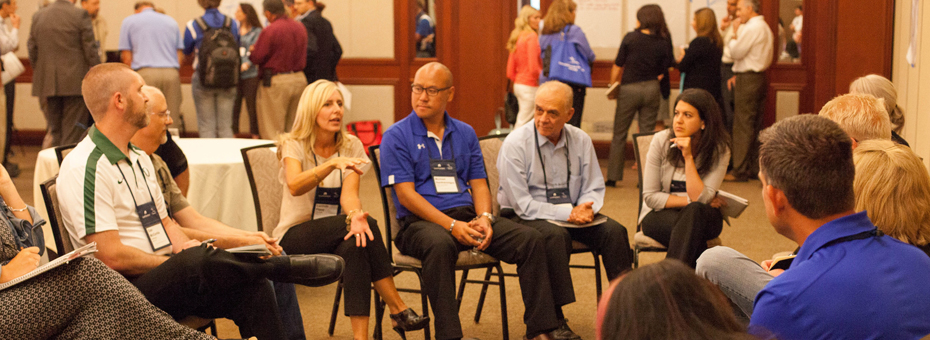Photo coutrtesy of Garret Hoover garrethoover.com
This was just one interesting question raised during this week’s Open Space at The Lean Coaching Summit in Long Beach, California.
Summit attendees actually participated in eight different Open Space conversations on coaching. I like Open Space because it’s a light, effective structure for organizing small and large group conversations in just a short amount of time. Participants decide conversation topics themselves, a handful of people (in this case, eight) host their own small group conversations, and everyone else decides which conversations they want to participate in. At the end of the session, each group shares their learning back with the full, larger group.
At LEI summits, these conversations are a way we hope lean practitioners can learn from each other. Below are the topics (and notes) that resulted from Tuesday’s session. What thoughts would you add? Let us know in the comments!
Notes are transcribed below exactly as recorded by each small group.
How do you continue to develop your lean team when running events, daily improvements, trainings, etc.?
• Schedule the time
• Develop a plan
• Competency matrix and gap assessment
• Benchmark
• Coaching – peer outside of the organization
• Webinar
• Ask: What is our problem? What’s the gap?
• Identify objectives and priorities
Scaling: moving from a small group/effort to a larger group/effort/system
Take proven successes and share them using a structured middle management effort. These managers can then use a “middle up and down” approach.
Performance reviews
• Behaviors need to be tied to performance goals and metrics
• Goals support the organization, not just one team
• Frequent assessment to improve and measure
• Behaviors need to be measurable
How do you break down silos?
• Value stream focus
• Share KPIs
• Understand who the customer is
• Remember “measures drive behavior”
• Discover why you have silos to begin with
• Ask: what is your culture? (understand what it is first)
• Link folks and communicate
How do we coach and motivate people when it seems efficiency works against hourly employees?
• Asking and confronting senior management about realities
• Lean is more likely to become part of culture with senior management practice
• Ask your boss for a new more assertive role
• Determine what drives senior management to change metrics
• Drive metrics to show issues
Coaching people who don’t want to be coached
There are many types of people who are resistant to coaching: the deflector, the interrupter, the “I know all the answers”, the “I know more than you”, the “I’ve seen managers come and go and you will, too”
• Understand the root cause of the person’s resistance to coaching through relationship
• Wait for moments of vulnerability
• Run experiments to break down walls
Coaching with humility in organizations that value winning
• Winning = all green, KPIs, heroism
• Humility would build trust, connecting transparency, vulnerability, learning, and change. You don’t know everything.
• People are a multiplier of results.
• Training for leading with humility has impacted culture and results
• Humble inquiry can be learned
• This is a cultural alignment issue
• Winning is ok – where do you win, team or org level (eg team based performance review)
• 360 view, senior leaders created change in culture (lasted about 2 yrs)
• Senior leaders need to encourage risk taking
• Balanced scorecard can help
• Fail fast
• Stop using traffic light – red, light, green
• Call things an experiment, failure is expected
• Identify metrics that value people development
• Provide clarity on what it means to be a leader
• Reward the right behavior
Best practices to onboard new lean coaches
Characteristics of a successful coach
1) passion for lean and systems
2) salesmanship – ability to influence
Best practices shared:
• Starbucks: Be coached, observe coaching, coach with an observer
• Job Instruction
• Shadow other coaches for a week
• Audit coaches to their standard work
Coaching up
• Create a lean charter
• Define purpose
• Create expectations between lean team and executives
• Develop relationships off-site and off-subject
• Differentiate between lean coach and executive coach
If you hosted one of these conversations or participated in this Open Space–let us know if and how you continue your conversation. (Some groups agreed to meet again by conference call. Other people simply exchanged cards and decided to touch base and discuss progress in pairs.) Whether you or not you participated in person, we invite you to continue any of these conversations on The Lean Post. We want to hear your stories and ideas! Submit here.






